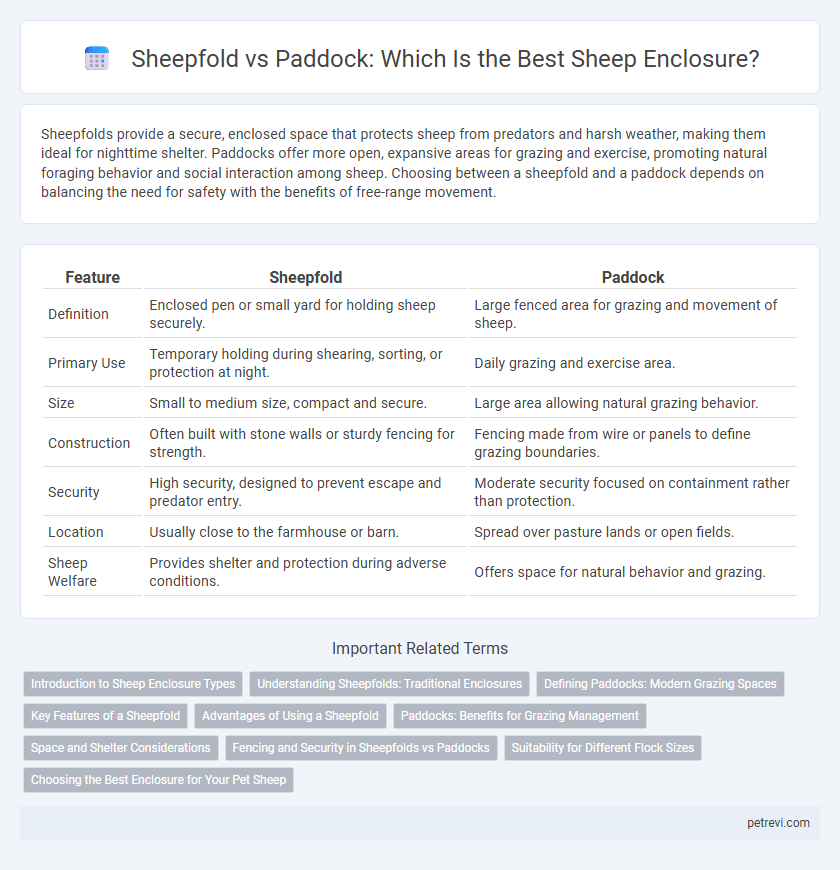Sheepfolds provide a secure, enclosed space that protects sheep from predators and harsh weather, making them ideal for nighttime shelter. Paddocks offer more open, expansive areas for grazing and exercise, promoting natural foraging behavior and social interaction among sheep. Choosing between a sheepfold and a paddock depends on balancing the need for safety with the benefits of free-range movement.
Table of Comparison
| Feature | Sheepfold | Paddock |
|---|---|---|
| Definition | Enclosed pen or small yard for holding sheep securely. | Large fenced area for grazing and movement of sheep. |
| Primary Use | Temporary holding during shearing, sorting, or protection at night. | Daily grazing and exercise area. |
| Size | Small to medium size, compact and secure. | Large area allowing natural grazing behavior. |
| Construction | Often built with stone walls or sturdy fencing for strength. | Fencing made from wire or panels to define grazing boundaries. |
| Security | High security, designed to prevent escape and predator entry. | Moderate security focused on containment rather than protection. |
| Location | Usually close to the farmhouse or barn. | Spread over pasture lands or open fields. |
| Sheep Welfare | Provides shelter and protection during adverse conditions. | Offers space for natural behavior and grazing. |
Introduction to Sheep Enclosure Types
Sheep enclosures are essential for managing and protecting flocks, with sheepfolds and paddocks serving distinct purposes. Sheepfolds are traditional walled or fenced yards providing secure, enclosed spaces for overnight shelter or protection from predators. In contrast, paddocks are fenced grazing areas designed to facilitate rotational grazing, optimizing pasture use and animal health.
Understanding Sheepfolds: Traditional Enclosures
Sheepfolds are traditional enclosures designed to provide secure shelter and protection for sheep, typically made from stone walls or wooden fences arranged in a circular or rectangular shape. Unlike paddocks, which are open grazing areas, sheepfolds offer a confined space that helps prevent losses from predators and facilitates easier management during lambing or shearing. The solid construction of sheepfolds ensures durability and protection against harsh weather conditions, making them a reliable choice for shepherds focusing on sheep safety and containment.
Defining Paddocks: Modern Grazing Spaces
Paddocks are modern grazing spaces designed to manage sheep effectively through rotational grazing, enhancing pasture health and preventing overgrazing. Unlike traditional sheepfolds, paddocks offer flexible, fenced areas that allow sheep to graze on fresh vegetation regularly, optimizing forage utilization. This method supports sustainable livestock management by promoting soil fertility and reducing parasite loads in sheep flocks.
Key Features of a Sheepfold
A sheepfold is a sturdy, enclosed structure designed to securely contain sheep, often featuring high stone or wooden walls that protect against predators and harsh weather. Unlike a paddock, which is an open, fenced grazing area, a sheepfold offers more controlled confinement for managing and sorting sheep. Key features include a solid gate for easy access, a raised design to prevent waterlogging, and ample ventilation to maintain animal health.
Advantages of Using a Sheepfold
Sheepfolds provide enhanced security and protection against predators compared to paddocks, offering a robust enclosed structure specifically designed for nighttime shelter. Their sturdy construction minimizes the risk of sheep escaping or being harmed during harsh weather conditions. Concentrated management within a sheepfold facilitates easier health monitoring, feeding, and lambing support, improving overall flock welfare and productivity.
Paddocks: Benefits for Grazing Management
Paddocks offer rotational grazing benefits by dividing pasture into smaller sections, enabling controlled grazing and promoting forage regrowth. This system reduces soil erosion and parasite buildup, improves pasture productivity, and enhances sheep health through varied nutrient intake. Efficient paddock management leads to sustainable land use and optimized wool and meat production in sheep farming.
Space and Shelter Considerations
A sheepfold offers a compact, secure enclosure typically used for overnight shelter, providing protection from predators and harsh weather conditions. In contrast, a paddock provides a larger, open space that allows sheep to graze freely while offering minimal shelter unless additional structures are installed. Optimal sheep management often combines both, using paddocks for daytime grazing and sheepfolds for safe nighttime confinement.
Fencing and Security in Sheepfolds vs Paddocks
Sheepfolds offer robust fencing options such as stone walls or heavy timber fences that provide enhanced security against predators and prevent sheep from escaping. Paddocks typically utilize lighter wire or electric fencing designed for rotational grazing, prioritizing ease of access and flexibility over maximum security. The solid construction in sheepfolds makes them ideal for long-term containment, while paddocks balance fencing cost and animal movement control.
Suitability for Different Flock Sizes
Sheepfolds offer secure, enclosed spaces ideal for managing large flocks, providing protection from predators and facilitating organized handling during shearing or medical care. Paddocks are better suited for smaller flocks, allowing rotational grazing that promotes pasture health and reduces parasite buildup. Choosing between a sheepfold and a paddock depends on flock size, management goals, and available land resources.
Choosing the Best Enclosure for Your Pet Sheep
A sheepfold offers a secure, enclosed area traditionally designed to protect sheep from predators and harsh weather, making it ideal for long-term housing. Paddocks provide a larger, fenced grazing space that supports natural foraging behavior and promotes exercise, crucial for the health of pet sheep. Selecting the best enclosure depends on balancing safety, grazing needs, and available space to ensure optimal welfare for your pet sheep.
Sheepfold vs Paddock for Sheep Enclosure Infographic

 petrevi.com
petrevi.com